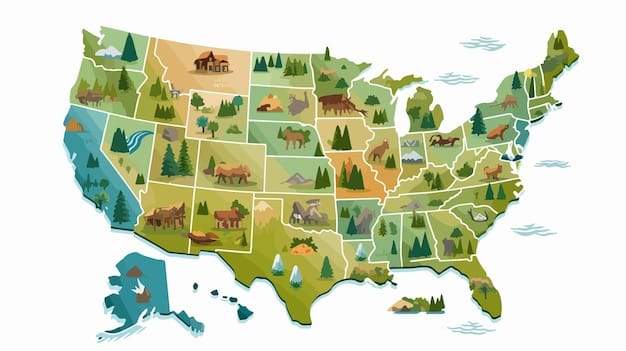ESA Regulation Updates: 2025 Conservation Impact Analysis

The updated Endangered Species Act regulations in 2025 are poised to significantly reshape conservation strategies by streamlining listing processes, enhancing habitat protection, and fostering greater collaboration among stakeholders, ultimately affecting biodiversity preservation and ecosystem health across the United States.
As we approach 2025, a critical question for environmentalists, policymakers, and the public alike is: How Will the Updated Endangered Species Act Regulations Impact Conservation Efforts in 2025? This landmark legislation, a cornerstone of American wildlife protection, is undergoing significant revisions, promising both opportunities and challenges for the future of endangered species.
Understanding the Endangered Species Act: A Historical Perspective and Its Evolution
The Endangered Species Act (ESA) of 1973 represents a monumental commitment by the United States to prevent the extinction of imperiled species and protect the ecosystems upon which they depend. Enacted during a period of heightened environmental awareness, the ESA has been instrumental in safeguarding countless species from the brink of disappearance. Its foundational principles center on scientific classification, habitat preservation, and the prohibition of activities that harm listed species.
Over its five-decade history, the ESA has faced numerous legislative challenges, judicial interpretations, and administrative adjustments. Each amendment and regulatory change has sought to refine its implementation, balance conservation goals with economic development, and adapt to evolving scientific understanding. These shifts reflect ongoing debates about federal authority, property rights, and the most effective approaches to biodiversity protection.
Key Components of the ESA’s Original Framework
The initial design of the ESA was comprehensive, establishing a robust framework for species protection. Understanding these original provisions is essential for grasping the significance of contemporary updates.
- Species Listing: The process by which species are identified as “endangered” or “threatened” based on the best available scientific and commercial data.
- Critical Habitat Designation: The identification of specific geographical areas essential for the conservation of a listed species, which often triggers additional protections.
- Prohibitions: Section 9 of the ESA outlines a broad set of prohibitions, including “taking” (harassing, harming, pursuing, hunting, shooting, wounding, killing, trapping, capturing, or collecting) endangered species.
- Recovery Plans: Mandates federal agencies to develop and implement plans for the recovery of listed species, outlining actions necessary for their restoration.
- Interagency Cooperation: Section 7 requires federal agencies to consult with the U.S. Fish and Wildlife Service (USFWS) or the National Marine Fisheries Service (NMFS) to ensure their actions do not jeopardize listed species or adversely modify their critical habitat.
The evolution of the ESA has been a dynamic process, influenced by political priorities, scientific advancements, and a growing understanding of ecological complexities. As we look towards 2025, the latest regulatory updates are poised to continue this trajectory, potentially reshaping how conservation is approached and executed across the nation, aiming for greater efficiency, clarity, and impact in the face of persistent environmental threats.
Major Regulatory Changes Expected in 2025
The conservation landscape of the United States is continuously shaped by policy, and 2025 marks a pivotal year for the Endangered Species Act (ESA) with significant regulatory updates on the horizon. These changes aim to address long-standing concerns regarding the efficiency, clarity, and effectiveness of the ESA’s implementation, promising a new era for wildlife protection and habitat management.
At the core of these revisions are efforts to streamline bureaucratic processes, enhance science-based decision-making, and foster greater collaboration among diverse stakeholders. While specific details are still being finalized, general directives point towards a more adaptive and outcomes-focused approach to species conservation. Many of the proposed changes are a response to criticisms from various sectors, including industry and some state governments, who have called for more flexibility and predictability in ESA compliance.
Streamlining the Listing and Delisting Process
One of the most impactful areas of reform targets the listing and delisting of species. Historically, this process has been perceived as lengthy and sometimes politically charged. The updated regulations are expected to:
- Accelerate Scientific Review: Implement quicker timelines for scientific assessments to ensure that decisions are based on the most current data.
- Clarify Criteria: Provide clearer definitions and criteria for what constitutes an “endangered” versus “threatened” species, reducing ambiguity and potential for legal disputes.
- Incorporate Economic Factors (with limitations): While the ESA’s core remains science-driven, there might be new guidelines for how economic impacts are considered during critical habitat designation, though not directly in the listing decision itself. The exact scope of this consideration remains a point of contention and careful implementation.
- Enhance Transparency: Increase public access to data and decision-making rationale throughout the listing process, aiming to build greater public trust and accountability.
These changes are designed to make the ESA more agile, allowing for faster responses to both declining and recovering species populations. The goal is to ensure that conservation efforts are initiated promptly when needed and resources are reallocated efficiently once species have recovered.
Modifications to Critical Habitat Designation and Protection
Critical habitat designation has always been a contentious aspect of the ESA, often drawing opposition due to perceived restrictions on land use. The 2025 updates seek to refine this process by:
- Focusing on Occupied vs. Unoccupied Habitat: Provide clearer guidance on when and how unoccupied habitat can be designated as critical, often requiring a stronger scientific justification for future recovery potential.
- Improving Economic Impact Assessments: Mandate more thorough analyses of the economic impacts of critical habitat designations, potentially leading to exclusions in certain areas if the benefits of exclusion outweigh the benefits of inclusion.
- Promoting Proactive Conservation: Encourage voluntary conservation efforts by landowners within or adjacent to critical habitats, possibly offering incentives or streamlined permitting for compatible activities.
These modifications aim to strike a better balance between protecting essential habitats and addressing the concerns of private landowners, who manage a significant portion of potential critical habitat. The aspiration is to make critical habitat designations more effective by garnering broader support and reducing conflicts that can impede conservation outcomes. The overarching goal remains the protection and recovery of species, but with a more nuanced approach to implementation.
Potential Positive Impacts on Conservation Efforts
The forthcoming updates to the Endangered Species Act regulations in 2025, while subject to scrutiny, hold considerable promise for bolstering conservation efforts across the United States. By addressing some of the historical challenges and criticisms, these revisions could pave the way for more effective, efficient, and collaborative approaches to protecting imperiled species and their habitats.
A key area of potential positive impact lies in the anticipated clarity and streamlining of regulatory processes. When regulations are easier to understand and navigate, they are often met with less resistance and can be implemented more consistently. This can translate into quicker action where species are in decline and more predictable outcomes for stakeholders involved in land use and development.

Enhanced Efficiency in Species Listing and Recovery
One of the most frequently cited benefits of the proposed changes is the potential for increased efficiency. A more streamlined listing process, particularly for species clearly on the brink, could lead to faster protective measures. This is crucial as delays in listing can sometimes be detrimental, allowing populations to dwindle further beyond reasonable recovery.
- Quicker Response Times: Expedited scientific reviews mean that species can be granted protection before their populations reach critically low levels, making recovery more feasible.
- Data-Driven Decisions: Emphasizing “best available scientific data” with expedited review cycles fosters a more dynamic and responsive conservation strategy.
- Adaptive Management: The ability to adjust listings and recovery plans based on real-time data and scientific advancements ensures that conservation efforts remain relevant and effective.
- Targeted Resource Allocation: By refining criteria and processes, resources can be more effectively directed towards species and habitats where interventions will yield the greatest impact, avoiding bureaucratic bottlenecks.
These advantages could result in more species being moved onto recovery lists and eventually delisted, signifying successful conservation. The goal is to shift from a reactive stance to a more proactive and adaptive approach, maximizing the impact of limited conservation resources.
Greater Collaboration and Incentives for Landowners
Another significant positive shift could come from increased emphasis on collaboration and incentives, particularly for private landowners. A substantial portion of endangered species habitat is on private land, making landowner cooperation indispensable for conservation success.
The updated regulations are expected to encourage voluntary conservation efforts by:
- Offering Clearer Guidance: Providing landowners with straightforward information on how to manage their land in ways that benefit listed species without fear of undue penalties.
- Developing Incentive Programs: Potentially expanding or creating new federal programs that offer financial or technical assistance to landowners for habitat restoration and management.
- Promoting Safe Harbor Agreements: Streamlining the process for agreements that provide assurances to landowners who voluntarily improve habitat for listed species, ensuring they won’t face additional regulations if species populations increase on their property.
- Enhancing Partnerships: Fostering stronger working relationships between federal agencies, state wildlife departments, local communities, and private organizations to create integrated, landscape-scale conservation initiatives.
By empowering landowners and integrating them more fully into conservation strategies, the ESA could transform from a regulatory burden into a catalyst for community-led biodiversity preservation. This shift from a potentially adversarial relationship to one of partnership is crucial for achieving long-term, sustainable conservation outcomes across diverse ecosystems.
Ultimately, the successful implementation of these updated regulations hinges on a commitment to their intended benefits. If executed thoughtfully, the 2025 changes have the potential to significantly enhance the efficacy of the Endangered Species Act, leading to a brighter future for America’s precious wildlife.
Potential Negative Impacts and Challenges
While the updated Endangered Species Act regulations in 2025 aim to refine and improve conservation efforts, they also carry potential downsides and present significant challenges. Any major legislative or regulatory shift inevitably creates ripples, and the ESA is no exception, particularly given its historical role as a battleground between environmental protection and economic interests.
One primary concern revolves around the balance between streamlining processes and maintaining the biological integrity of conservation decisions. There’s a delicate line between efficiency and thoroughness, and any deviation too far in one direction could inadvertently compromise species protection.
Risk of Weakened Protections for Certain Species
A significant apprehension among some conservation groups is that certain regulatory changes might inadvertently weaken protections for vulnerable species. Concerns have been raised particularly about adjustments to critical habitat designation and the differentiation between “endangered” and “threatened” species.
- Lessened Habitat Safeguards: If economic considerations are given undue weight in critical habitat decisions, there’s a risk that crucial areas might be excluded from protection, even if biologically essential for a species’ recovery.
- Differentiation of Endangered vs. Threatened Species: Historically, threatened species received nearly the same protections as endangered species under the “4(d) rule.” If this automatic application is removed or significantly diluted, newly listed threatened species might face fewer immediate safeguards, potentially allowing their populations to decline further before robust protections are initiated.
- Increased Delisting Pressures: While efficient delisting for recovered species is positive, concerns exist that political or economic pressures could prematurely push for delisting before species have achieved genuine, sustainable recovery.
- Reduced Federal Oversight: Any efforts to reduce federal “overreach” could diminish the active role of the USFWS and NMFS in specific conservation actions, leaving gaps that state agencies or private entities may not be fully equipped or willing to fill.
Such changes could create loopholes or reduce the preemptive power of the ESA, putting species at greater risk of habitat loss, population decline, and ultimately, extinction. The devil, as always, will be in the details of implementation and enforcement.

Challenges in Implementation and Enforcement
Beyond the potential for weakened protections, the updated regulations will undoubtedly face practical challenges in their implementation and enforcement. The complexity of the ESA, coupled with its broad geographic scope and diverse stakeholder base, makes any major regulatory overhaul a logistical undertaking.
Key challenges include:
- Resource Constraints: Federal agencies responsible for ESA implementation (USFWS, NMFS) often operate with constrained budgets and staffing. New regulations, even if designed for efficiency, still require significant resources for training, adaptation, and oversight.
- Legal Battles and Ambiguity: Any substantial changes to such a foundational law are almost certain to be met with legal challenges from various interest groups, leading to prolonged uncertainty and potential delays in implementation. Ambiguous language in the new rules could exacerbate this.
- State and Local Buy-in: Effective conservation often requires cooperation at state and local levels. If new federal regulations are perceived as overly burdensome or inadequate, achieving consistent buy-in from diverse local governments and communities could prove difficult, hindering coordinated conservation strategies.
- Adapting Scientific Protocols: Integrating new scientific methodologies or criteria for listing and habitat designation will require significant investment in research, data collection, and expert review, demanding an adaptive and well-funded scientific apparatus.
Navigating these challenges will require careful planning, transparent communication, and a willingness to adapt even after initial implementation. The effectiveness of the 2025 updates will ultimately be measured not just by their written provisions, but by their practical application and the real-world outcomes for endangered species.
Stakeholder Perspectives: What Different Groups Are Saying
The Endangered Species Act has always been a lightning rod for diverse opinions, and the upcoming 2025 regulatory updates are no exception. Various stakeholder groups, each with their own priorities and interpretations, are closely watching these changes, expressing a range of hopes, concerns, and predictions about their impact on conservation efforts. Understanding these perspectives is crucial for a comprehensive view of the ESA’s future.
From environmental advocacy organizations to agricultural industries and governmental agencies, the proposed adjustments spark heated debate. These discussions often highlight the complex interplay between ecological preservation, economic development, and legal precedent, underscoring the multifaceted challenges inherent in species protection.
Environmental and Conservation Organizations
For environmental and conservation groups, the ESA is often seen as a last line of defense for biodiversity. Their primary focus is on ensuring that the updated regulations provide robust, science-based protections for imperiled species, without compromise. Many express strong reservations about any changes that could potentially weaken the Act’s effectiveness.
- Concerns about Delisting and Habitat Protection: Many groups voice apprehension that changes allowing greater economic consideration in critical habitat designation or altering the “4(d) rule” for threatened species could expose vulnerable populations to increased risks. They advocate for decisions to remain primarily rooted in biological science.
- Demand for Robust Scientific Integrity: They emphasize the need for stringent adherence to scientific evidence in all listing, delisting, and recovery decisions, asserting that political or economic influence should not supersede biological realities.
- Advocacy for Collaborative Approaches: While cautious, many also acknowledge the potential benefits of enhanced collaboration and incentive programs for landowners, provided these do not substitute for mandatory protections where necessary. They seek true partnerships, not regulatory retreats.
- Focus on Climate Change Integration: Forward-thinking environmental groups are also pushing for the updated regulations to explicitly incorporate the impacts of climate change on species and habitat, advocating for more adaptive and resilient conservation strategies.
Overall, environmental groups are vigilant, ready to challenge perceived loopholes or weaknesses in court, and actively push for the strongest possible interpretation and application of the updated ESA to ensure its core mission of species preservation remains intact.
Industry and Private Landowners
Conversely, industry sectors (such as oil and gas, timber, real estate, and agriculture) and many private landowners often view the ESA through the lens of economic impact and land use restrictions. Their perspectives frequently center on the need for greater predictability, flexibility, and reduced regulatory burden.
- Desire for Regulatory Certainty: Industries often seek clear guidelines and consistent application of the ESA to minimize project delays and legal uncertainties. They argue that ambiguities can hinder economic development and investment.
- Call for Economic Consideration: Many in these sectors advocate for a more explicit and substantial role for economic factors in critical habitat designation, arguing that conservation efforts should be balanced with the livelihoods and economic stability of communities.
- Support for Incentive-Based Programs: Private landowners, in particular, are often receptive to programs that provide financial incentives, technical assistance, or “safe harbor” assurances for voluntary conservation actions, seeing these as more effective than punitive regulations.
- Streamlined Permitting Processes: There is a strong desire for more efficient environmental review and permitting processes, especially for projects that might interact with listed species, to reduce costs and timelines.
These stakeholders often advocate for a more collaborative and less confrontational approach, believing that achieving conservation goals alongside economic prosperity is possible through well-defined, flexible, and incentivizing regulations. Their engagement often focuses on shaping rules that allow for both conservation and responsible economic use of natural resources.
The divergence in these perspectives highlights the intricate balance lawmakers and agencies must strike. The 2025 ESA updates represent an ongoing attempt to reconcile these competing interests, with the ultimate litmus test being their effect on the long-term health of America’s biodiversity.
Lessons from Past ESA Revisions and Their Outcomes
To truly grasp the potential implications of the 2025 Endangered Species Act (ESA) regulatory updates, it is beneficial to look back at previous attempts to revise or reform this pivotal piece of legislation. The history of the ESA is replete with adjustments, some achieving their intended goals, while others generated unforeseen consequences or became mired in controversy. These past experiences offer valuable lessons for interpreting the current trajectory.
Throughout its history, the ESA has been a target for both simplification and strengthening. Each period of proposed or enacted change has been driven by varying political climates, scientific advancements, and the practical challenges of implementation. The outcomes of these past revisions underscore the complexity of balancing conservation goals with societal needs.
Case Studies of Prior Amendments and Their Impact
Several significant periods of ESA revision provide critical insights into how similar changes might unfold in 2025:
- 1982 Amendments (Habitat Conservation Plans – HCPs): This revision introduced the concept of Habitat Conservation Plans (HCPs), allowing incidental “take” of listed species under certain conditions, provided the overall conservation benefits outweighed the harm.
- Outcome: HCPs have diversified conservation approaches, allowing for greater flexibility and private landowner engagement. However, their effectiveness has been debated, with some critics suggesting they can occasionally lead to insufficient mitigation or complex bureaucratic hurdles.
- Late 1990s and Early 2000s Efforts (No Significant Amendment, but Administrative Changes): While no major legislative amendments passed, this era saw administrative efforts to clarify “critical habitat” designation and address concerns about property rights.
- Outcome: These administrative adjustments often led to increased litigation, as different groups challenged interpretations. They highlighted the difficulty of making significant changes without legislative consensus, often resulting in policy volatility.
- Trump Administration Regulations (2019 Amendments): These administrative changes sought to streamline the ESA, notably by eliminating the blanket “4(d) rule” for threatened species (meaning threatened species would not automatically receive the same protections as endangered ones) and allowing for more explicit consideration of economic impacts in listing decisions.
- Outcome: These changes were highly controversial and faced immediate legal challenges from environmental groups. While some aspects were implemented, they created significant uncertainty and were largely reversed by the subsequent Biden administration, demonstrating the political sensitivity and legal vulnerability of major ESA changes.
These historical examples illustrate that even well-intentioned revisions can lead to unforeseen consequences, legal battles, or pendulum swings in policy depending on the political landscape. The key lesson is that the durability and success of ESA updates depend not only on their design but also on the consensus they can garner and their resilience against legal and political challenges.
Key Takeaways for 2025 Implications
Drawing from these past experiences, several critical takeaways emerge for understanding the potential implications of the 2025 regulations:
- Litigation is Inevitable: Any significant changes to the ESA are almost guaranteed to face legal challenges from affected parties. This means implementation can be slow, costly, and subject to court-ordered injunctions or reversals.
- Balancing Act is Crucial: The success of the regulations often hinges on how well they balance core conservation principles with economic realities and stakeholder cooperation. Leaning too heavily in one direction can alienate crucial groups.
- Importance of Scientific Integrity: Past attempts to inject non-scientific factors (e.g., purely economic) directly into listing decisions have consistently been met with strong opposition and legal challenges, proving that maintaining the scientific basis of species protection is paramount for the Act’s legitimacy.
- Administrative vs. Legislative Power: Administrative changes, while quicker, are often less stable than legislative amendments. They are more easily overturned by subsequent administrations, leading to policy inconsistency. The 2025 updates, being regulatory, will likely share this vulnerability.
- Public Engagement Matters: Periods of ESA revision often galvanize both proponents and opponents, highlighting the importance of clear communication, public education, and sustained engagement to build support for conservation initiatives.
As the 2025 updates unfold, observers will be looking for signs of whether they have learned from these past lessons. Clarity, scientific grounding, and a thoughtful approach to stakeholder concerns will be crucial in determining whether these revisions strengthen the ESA or merely add another chapter to its contentious history.
Preparing for the Future: Recommendations for Conservationists and Policymakers
As the 2025 updated Endangered Species Act (ESA) regulations approach, both conservationists and policymakers face a critical juncture. The success of these reforms—and indeed, the future of countless species—hinges on proactive preparation, strategic adaptation, and a renewed commitment to collaborative solutions. It is not enough to simply react to the changes; a forward-thinking approach is necessary to maximize positive outcomes and mitigate potential risks.
The landscape of conservation is constantly evolving, influenced by climate change, habitat fragmentation, and ever-present economic pressures. The new ESA regulations provide an opportunity to refine strategies, but only if stakeholders are prepared to navigate the complexities and leverage new tools effectively. This preparation demands flexibility, innovation, and a steadfast dedication to the ESA’s core mission.
Strategic Adjustments for Conservation Organizations
Conservation organizations will need to be agile in adapting their strategies to the new regulatory environment. This involves not only understanding the nuances of the updated rules but also developing innovative approaches to advocacy, partnership, and on-the-ground conservation.
- Deep Dive into New Regulations: Organizations must thoroughly analyze each new stipulation, understanding precisely how it impacts listing processes, habitat designations, and recovery plan implementation. This detailed knowledge will be critical for effective advocacy and legal challenges if necessary.
- Enhanced Legal Preparedness: Given the historical pattern of litigation surrounding ESA changes, conservation groups should be prepared for potential legal action to challenge or defend specific aspects of the new regulations, ensuring strong legal teams are ready.
- Strengthened Data Collection and Science Advocacy: The emphasis on “best available science” means organizations must double down on their efforts to conduct robust research, monitor species populations, and ensure that scientific data is effectively presented and considered in all decision-making processes.
- Building Broader Coalitions: Engaging with a wider range of stakeholders—including landowners, local communities, and even sympathetic industry voices—will be more important than ever. Collaborative partnerships can lead to more durable conservation solutions and create a unified front for species protection.
- Proactive Habitat Management: Beyond simply reacting to listings, conservationists should focus on proactive, landscape-scale habitat restoration and connectivity initiatives that build resilience against future threats, regardless of regulatory shifts.
By adopting these strategic adjustments, conservation organizations can ensure their efforts remain impactful, resilient, and effective regardless of the regulatory winds, securing a stronger future for endangered species.
Policy Recommendations for Effective Implementation
For policymakers and federal agencies (USFWS, NMFS), the challenge lies in implementing the new regulations in a manner that is both consistent with the law’s intent and effective on the ground. Clear communication, resource allocation, and a commitment to continuous improvement will be paramount.
- Clear and Consistent Guidance: The agencies must issue comprehensive, unambiguous guidance documents for field offices, state agencies, and the public. Inconsistent or vague interpretations can lead to confusion, delays, and legal challenges.
- Adequate Resource Allocation: Sufficient funding and staffing for increased scientific review, compliance monitoring, and new incentive programs are essential. Efficiency should not come at the expense of capacity.
- Transparent Decision-Making: Maintaining a high degree of transparency in all listing, habitat designation, and recovery plan decisions will build public trust and reduce the perception of political manipulation. All data and rationales should be publicly accessible.
- Facilitating Interagency Coordination: Strengthening cooperation among federal agencies and with state, tribal, and local governments is critical. Integrated approaches are more likely to succeed in complex conservation scenarios.
- Monitoring and Adaptive Management: Establish robust monitoring programs to track the real-world impacts of the new regulations on species populations and habitat. Be prepared to adapt and refine rules based on empirical evidence, embodying a true adaptive management philosophy.
By focusing on these policy recommendations, the implementers of the ESA can aim to maximize the act’s effectiveness, fostering conditions where both economic progress and species recovery can proceed hand-in-hand, safeguarding America’s precious biodiversity for generations to come. The future of wildlife conservation rests on a shared commitment to wise policy and dedicated action.
The Role of Technology and Citizen Science in 2025 Conservation
As the updated Endangered Species Act (ESA) regulations take effect in 2025, the landscape of conservation is not only shaped by policy but also increasingly by technological advancements and the burgeoning power of citizen science. These tools offer unprecedented opportunities to enhance data collection, improve monitoring, and engage a wider public in species protection efforts, potentially ushering in a more dynamic and inclusive era for wildlife conservation.
The ability to collect, process, and analyze vast amounts of ecological data swiftly and accurately is transforming how conservation scientists operate. Simultaneously, the growing popularity of citizen science empowers everyday individuals to contribute valuable observations, expanding the reach and resolution of monitoring efforts far beyond what professional scientists alone could achieve.
Leveraging Advanced Technologies for Monitoring and Data Analysis
Cutting-edge technologies are revolutionizing many aspects of conservation, offering more precise and extensive ways to track species, monitor habitats, and understand ecological processes. The updated ESA framework can significantly benefit from the strategic integration of these tools.
- Remote Sensing and Satellite Imagery: High-resolution satellite imagery and drone technology enable continuous monitoring of large habitat areas, tracking deforestation, land-use changes, and even species movements without disturbing wildlife. This data can inform critical habitat designations and recovery plan effectiveness.
- AI and Machine Learning for Data Analysis: Artificial intelligence can process vast datasets from various sources (camera traps, acoustic sensors, genomic sequencing) to identify patterns, predict species distribution, and model impacts of environmental change more rapidly and accurately than ever before.
- Genetic and Genomic Tools: Advances in genetic analysis provide crucial insights into population health, genetic diversity, connectivity between populations, and identification of cryptic species or illegal wildlife trade, all vital for listing and recovery efforts.
- Acoustic Monitoring: Automated acoustic sensors can detect and identify species by their unique vocalizations, passively monitoring biodiversity in areas that are difficult to access, proving invaluable for nocturnal or elusive species.
- GIS and Predictive Modeling: Geographic Information Systems (GIS) provide powerful platforms for spatial analysis, helping to map species ranges, identify critical corridors, and predict the impacts of climate change or development scenarios on habitats.
The effective integration of these technologies can enhance the scientific rigor of ESA decisions, providing a more robust evidence base for listing, designating critical habitat, and assessing recovery progress. This technological edge supports more informed and adaptive management strategies.
The Empowering Role of Citizen Science Initiatives
Citizen science, wherein members of the public participate in scientific research, is emerging as a powerful force in conservation. Enabling non-experts to contribute valuable data significantly expands the scale and scope of monitoring and awareness.
- Expanded Data Collection: Volunteers can collect vast amounts of geographical and temporal data on species occurrences, behavior, and habitat conditions, particularly for widely distributed or common species, complementing professional surveys. Projects like eBird or iNaturalist are prime examples.
- Increased Public Awareness and Engagement: Participating in citizen science projects fosters a deeper understanding and appreciation for local biodiversity, converting passive observers into active participants and advocates for conservation.
- Early Detection of Environmental Changes: Large networks of citizen scientists can serve as early warning systems for unusual animal sightings, disease outbreaks, or habitat degradation, prompting quicker responses from management agencies.
- Cost-Effective Monitoring: Mobilizing volunteers can significantly reduce the costs associated with extensive field surveys, allowing conservation budgets to stretch further and cover more ground.
- Generating Localized Data: Citizen science is particularly adept at collecting highly localized data, which can be critical for understanding specific habitat needs and population dynamics at a fine-grained scale, especially relevant for local conservation planning.
The updated ESA regulations in 2025 have an opportunity to explicitly recognize and encourage the integration of citizen science data, setting guidelines for its validation and use in formal conservation decisions. By harnessing the collective power of technology and an engaged citizenry, conservation efforts can become more comprehensive, data-rich, and ultimately, more successful in safeguarding America’s natural heritage.
| Key Point | Brief Description |
|---|---|
| 🔄 Streamlined Processes | Changes aim to accelerate species listing/delisting and critical habitat designation, potentially leading to faster conservation responses. |
| 🤝 Enhanced Collaboration | New regulations seek to foster greater cooperation with private landowners via incentives and clear guidelines. |
| ⚖️ Potential Challenges | Risks include weakened protections if economic factors overshadow biological science, and challenges in consistent implementation. |
| ✨ Tech & Citizen Science | Advanced technologies and public participation expected to boost monitoring, data analysis, and engagement in conservation efforts. |
Frequently Asked Questions About ESA Updates
The primary goals are to streamline and clarify the listing and delisting processes for species, enhance the efficiency of critical habitat designations, and foster greater collaboration with stakeholders. The aim is to make the Endangered Species Act more adaptive and outcome-focused while ensuring robust species protection. This includes leveraging scientific data more effectively across federal agencies.
Critical habitat designation changes could include clearer guidelines for including unoccupied habitats and more explicit consideration of economic impacts. The goal is to strike a better balance between conservation needs and landowner concerns. While economics won’t directly influence listing decisions, they may guide the scope of designated habitat. This aims for more transparent and defensible decisions.
The impact is a subject of debate. Proponents argue for increased efficiency and collaboration, leading to better outcomes. Critics fear that certain provisions, like giving more weight to economic factors or altering protections for threatened species, could inadvertently weaken safeguards. The ultimate effect will largely depend on the specifics of their implementation and enforcement by federal wildlife agencies.
Technology is expected to play a crucial role, with advancements in remote sensing, AI-driven data analysis, and genetic tools enhancing monitoring and decision-making. These technologies provide more precise data for tracking species populations and habitat conditions. They will enable more informed and efficient management strategies, supplementing traditional conservation methods. Citizen science platforms will also broaden data collection efforts.
Private landowners can adapt by engaging with federal agencies, understanding new incentive programs (like Safe Harbor Agreements), and seeking clear guidance on land management that benefits species. The updates aim to foster more cooperative conservation approaches, potentially reducing regulatory burdens for those who voluntarily participate. Early engagement can help avoid future conflicts and promote a positive conservation impact.
Conclusion
The 2025 updates to the Endangered Species Act regulations represent a significant chapter in America’s ongoing commitment to wildlife conservation. These revisions aim to streamline processes, enhance collaborative efforts, and integrate modern tools, aspiring to create a more efficient and effective framework for protecting imperiled species. While challenges and debates surrounding potential impacts on species protection remain, the opportunity for a more adaptive, scientifically informed, and stakeholder-engaged approach to conservation is clear. The success of these refreshed regulations will ultimately be measured by their ability to foster healthier ecosystems and ensure the long-term survival of the nation’s diverse and invaluable wildlife heritage.





